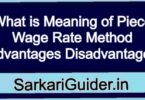
First-in-first out (FIFO) Method
FIFO method is based on the assumption that materials which are purchased first are issued first. It uses the price of the first batch of materials purchased for all issues until all units from this batch have been issued.
After the first batch if fully issued, the prices of the next batch received becomes the issue price. When this batch is also fully issued, the price of the further next batch issued for pricing and so on.
In other words, the materials are issued at the oldest cost price listed in the stores ledger account and thus, the materials in stock are valued at the price of the latest price.
However, an endeavor is made in the method that materials which run the risk of obsolescence are issued first.
Advantages of FIFO Method
The system the following advantages.
1. It is based on a realistic assumption that materials are issued in the order loss of the receipts.
2. Materials are issued at actual cost and thus no unrealistic profit or arises from the operation of this method.
3. This method is easy to understand and simple to operate.
4. The value of closing stock will reflect current market.
5. If purchase are few and if the prices are of materials remain stable price. the method will be simple to operate.
6. This method is useful when prices are falling.
7. It is a logical method because it taken into consideration the normal procedure of utilizing first those materials which are received first.
Disadvantages of FIFO Method
This method suffers from the following disadvantages:
1. It involves complicated calculations and hence increases the possibility of clerical errors.
2. For pricing one requisition more than one price has often to be taken.
3. When prices rise the issue price does not reflect the market prices as materials are issued from the earliest consignments.
4. In case of fluctuations in prices of materials, comparison between one job and the other job becomes difficult because one job started a few minutes later than another of the same nature may be issued at different prices .
5. During the period of falling prices cost of production tends to be high. This may lead to cancellation of prospective sales because of high quotation.
Suitability of the Method
This method is most suitable in times of falling prices because the issue price of materials to jobs will be ingang wineries cost of replacement of materials will be low.
But in case of rising prices, this method is not suitable because the issue price of materials to production will be low while the cost of replacement of materials will be high.
This method is useful for materials which are subject to obsolescence and deterioration In periods of rising prices, the FIFO method produces higher profits and results in higher tax liability because lower cost is charged to production Conversely in periods of falling, prices.
The FIFO method produces lower profits and results in lower taxes because they are derived from a higher cost of goods sold.
Impact of FIFO Method on Cost of Production
Following are the impact of this method on cost of production:
1. Cost of production does not reflect the current market price of materials because purchase rates of the car list and subsequent lots of purchase are adopted for issue purpose.
2. The cost of production is not accurate but only arbitrary especially when materials prices fluctuate widely. This is because cost of production consists of issue prices of different lots of purchases.
3. The cost of production is overstated and understated depending upon the situation of fluctuation in the prices of materials in the market.
Impact of FIFO Method on Inventory Valuation
Following are the impact of this method on Inventory Valuation-
1. When materials prices increases, the value of stock is understated and when material prices decrease, the value of closing stock is overstated.
2. The total value of stock fluctuates with the rise and fall in the cost of materials. This distorts the valuation of the stock accurately.
3. The value of closing stock reflects current market price.
Impact of FIFO Method on the profit
The profit is unaffected by the overstatement in cost as this compensated by a corresponding understatement in closing stock value and vice versa.
However, as production cost of a particular product or job is distorted by a rise or fall in the material cost consequently profit on such product or will also fall or rise.
इसे भी पढ़े…
- Definition of Primary Distribution of Overheads
- What is Re-Apportionment of Service Departments Overheads
- Process of Classification of Overheads | Basis of Overhead Classification
- What is Overheads | Bases For Allocation of Expenses to Departments
- What is Meaning of Incentive Wage Method | Methods of Wage Payment
- Meaning of Collection Allocation | Apportionment of Overhead Expenses
- What is Primary Distribution of Overheads
- What is Meaning of Overhead | Classification of Overhead
- Process of Classification of Overheads | Basis of Overhead Classification
- Advantages of Fixed and Variable Overheads | Difference Between Fixed & Variable Overheads
- What is Absorption of Selling and Distribution Overheads
- What is Money, Definition, Functions and various kinds of Money
- What is Apportionment of Overheads, Principles, Difference






